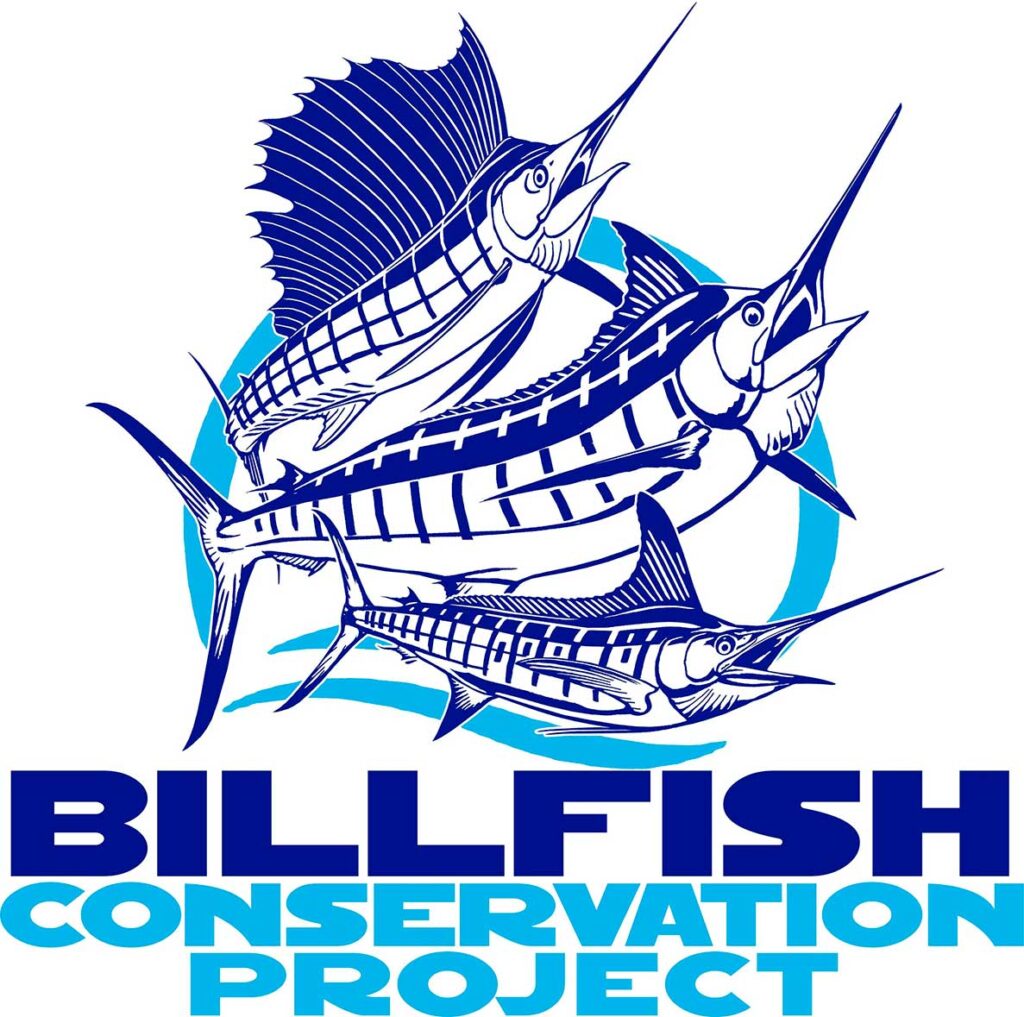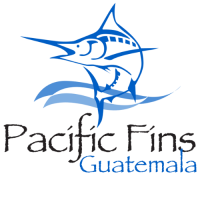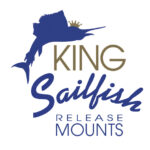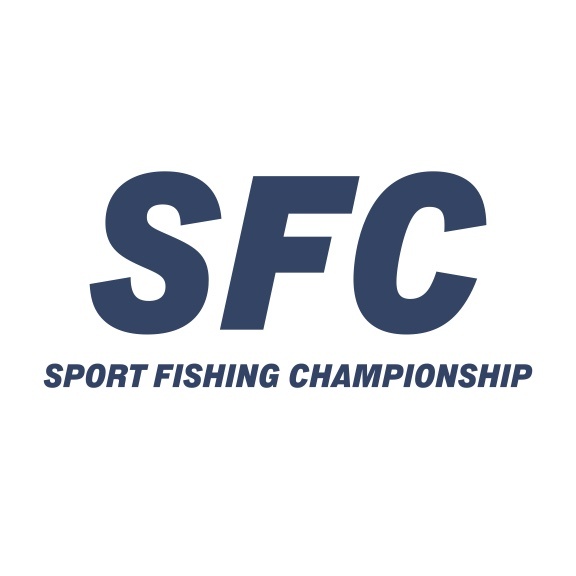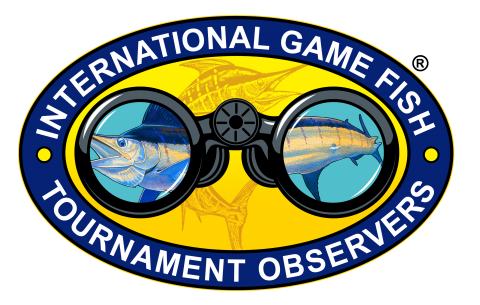Our PROJECTS
Billfish conservation Projects
Seasonal Availability of sailfish in sportfisheries in Guatemala
The Billfish Conservation Project has conducted an in-depth study on the seasonal availability of sailfish in Guatemala’s sport fisheries, led by Dr. Nelson Ehrhardt, Professor Emeritus at the University of Miami’s Rosenstiel School of Marine, Atmospheric, and Earth Sciences. Key findings from the project include:
Year-Round Presence: Sailfish are present throughout the year in Guatemala’s coastal waters, with varying catch rates influenced by seasonal oceanographic conditions.
Peak Season (November – May):
- Highest catch rates observed during these months.
- Influenced by the Tehuano winds, which drive nutrient-rich upwellings, enhancing prey availability and attracting sailfish.
Off-Peak Season (June – October):
- Lower catch rates due to changes in ocean currents and reduced upwelling activity.
- Sailfish remain in the area but are less concentrated.
Environmental Factors:
- The Eastern Tropical Pacific Ocean (ETPO), where Guatemala is located, experiences significant vertical habitat compression due to low oxygen zones at mid-ocean depths.
- This compression forces sailfish and their prey into shallower, more accessible waters, particularly during certain seasons.
Conservation Concerns:
- Despite high catch rates, sailfish face threats from bycatch in commercial tuna and mahi-mahi fisheries.
- Sustainable fishing practices and conservation efforts are essential to maintain healthy sailfish populations.
For a comprehensive understanding and detailed data, please refer to the full report
Computer lab in Local Schools
We are pleased to announce a significant and transformative donation to the Escuela Santa Marta in Iztapa, Escuintla. The Guy Harve Foundation, in collaboration with the Billfish Conservation Project, has generously donated a state-of-the-art computer lab to the local school.
The Donors
Guy Harvey Foundation
The Guy Harvey Foundation, founded by Dr. Guy Harvey, is a non-profit organization dedicated to the conservation of marine life and the preservation of our oceans. The foundation focuses on research, education, and advocacy to promote sustainable practices and ensure the future health of our marine ecosystems.
Billfish Conservation Project
The Billfish Conservation Project is a joint initiative that aligns with the goals of the Guy Harvey Foundation. It aims to protect and restore billfish populations while promoting responsible angling and fisheries management. This project recognizes the importance of healthy marine environments and their interconnectedness with our planet’s well-being.
The Donation
The collaborative efforts of the Guy Harvey Foundation and the Billfish Conservation Project have resulted in the donation of a cutting-edge computer lab to Buena Vista School. This donation includes: Hardware, Software, Internet Conectivity, Furniture and infraestructure.
Impact in Education
The donation of this computer lab is poised to revolutionize the educational experience at Buena Vista School in several ways: digital literacy, research and exploration, collaboration, innovation.
Buena Vista School extends its heartfelt gratitude to the Guy Harvey Foundation and the Billfish Conservation Project for their dedication to education and the betterment of our school community. This remarkable donation underscores the positive impact that collaborations between non-profit organizations and educational institutions can have on the lives of young learners.
The donation of a computer lab to Buena Vista School marks a significant milestone in our journey towards providing an enriched and forward-looking education for our students. We eagerly anticipate the innovative projects, enhanced learning experiences, and endless possibilities that this donation will unlock.
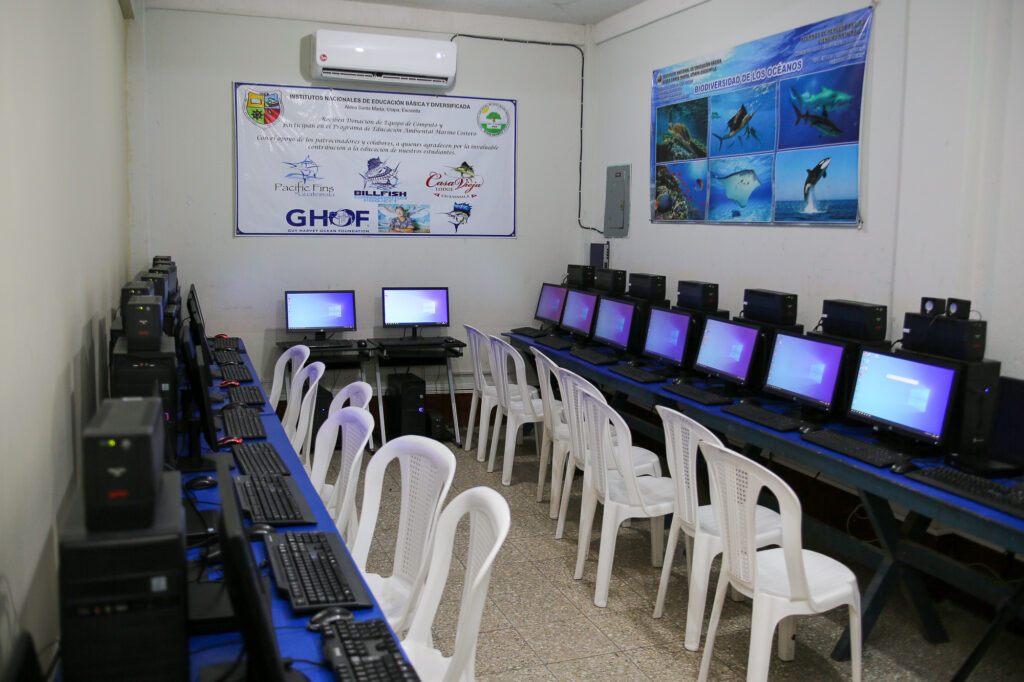


Satellite tagging expedition
Billfish Conservation Project will host and fund satellite tagging trips for many years and we are proud of the research we have conducted thus far.
Our goal is to increase the understanding of the distribution and behavior of billfish in the region, increasing the participation of recreational billfish anglers, and supply data for scientific purposes in their research for years to come. Our ability to successfully tag these fish means so much to the management and conservation efforts.
BCP Tagging expedition links recreational anglers with advanced satellite tagging technology to study the ecology of billfish species worldwide.
BCPs Tagging expedition seeks to obtain the information necessary to better inform the resource managers and policy makers to ensure a long term sustainability with economical, environmental and recreational purposes.
In April 2018 at the Guatemala Celebrity Pro-am invitation fishing tournament, University of Miami researchers deployed 10 satellite tags off the coast of Guatemala to study the behavior and habitat use of sailfish in the Eastern Pacific Ocean (EPO). Of the 10 satellite tags, 7 produced high quality datasets while 1 tagged sailfish was caught by commercial fisherman off Mexico and 1 tagged sailfish died due to postrelease mortality. The final remaining tag status remains unknown and likely represents a mortality or fishery event.
Of the 7 tags with data, no sailfish travelled eastward toward El Salvador and Nicaragua while all tagged sailfish traveled westward, northwestward or southwestward (Figure 1 Top). This is consistent with the majority of sailfish tagged throughout the EPO.
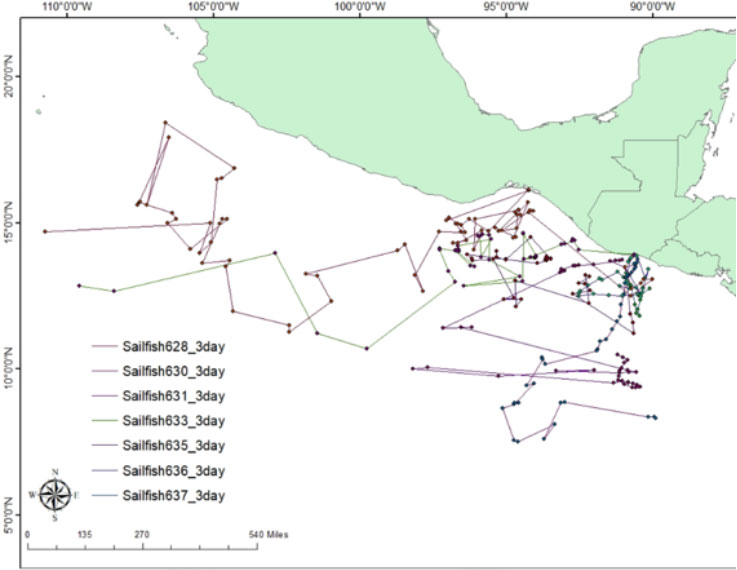
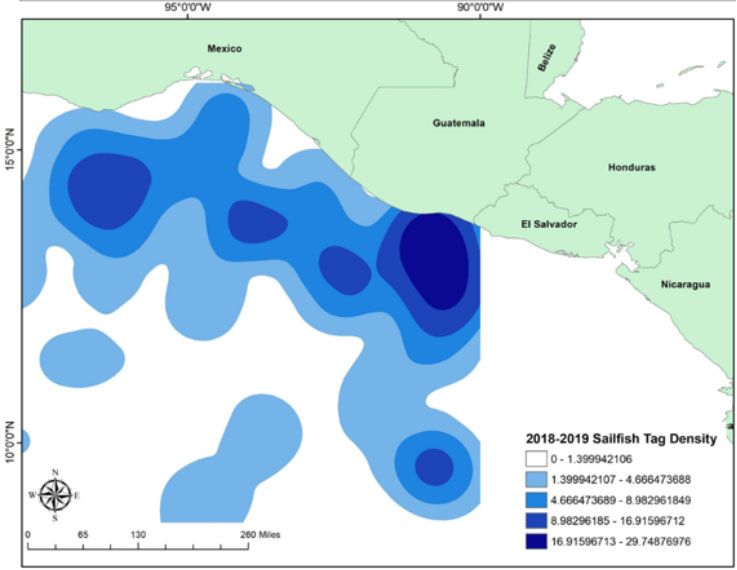
Figure 1: (Top) Map of seven satellite tags placed on sailfish off Guatemala in April 2018. (Bottom) Zoomed in map of sailfish tag density created from satellite tag data showing regions of highest sailfish presence in shades of blue with darker shades inidicating higher levels of tag density.
Sailfish travelled to regions known to be productivity hotspots such as the San Jose Canyon off the coast of Guatemala and the Tehuantepec upwelling system south of the Mexican coast indicated by the darker blue in Figure 1 bottom plot. Tagged sailfish tended to immediately leave the tagging location after the tagging event but only 2 of these made long distance migratory movements outside of the EPO region toward the west. The majority of sailfish stayed in the region with multiple sailfish returning to the relative location where tagging occurred.
The likelihood of sailfish to remain coastal within the Guatemalan economic zone region is critical for management and conservation as measures to protect this species within Guatemala may be more effective than in other locals given the high density of local sailfish. Through regional conservation regulations such as those put in place by the Guatemala Sailfish Conservation Commission, it will be possible to maintain the high catch rates seen historically in the region.
Sailfish preference for specific habitat ranges can be obtained from the tagging data and when analyzed next to sea surface temperature, a clear preference for the EPO warm pool is present (Figure 2). Here we see a preference for waters between 29o and 30o Celsius with a range of 26o to 32o Celsius. This is just one example of sailfish preference estimation made possible with the use of satellite tagging data and available satellite oceanographic information.
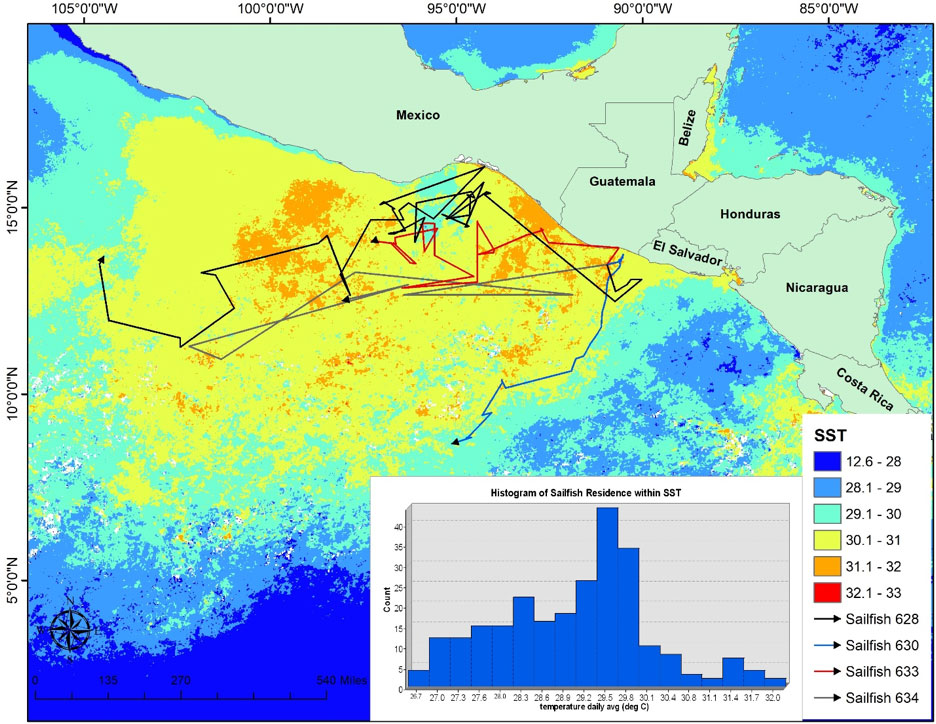
Figure 2: An example of four satellite tag sailfish tracks shortened for analysis of EPO warm pool preference.
Beach Clean Ups
The beach clean up project is an ambtitious iniciativer aimed at fostering enviromental awarness, engaging local communities and making a tangible impact on the cleanliness and health of our coastal ecosystems. By organizing regular clean-up events and educational activities, we seek to address the pressuring issue of marine pollution and contribute to the preservation of our oceans and marine life.
Objectives:
Environmental Stewardship: Raise awareness about the importance of protecting our oceans and beaches, nurturing a sense of responsibility for our environment among community members.
Litter Removal: Collect and properly dispose of marine debris, plastic waste, and other pollutants from the coastline, preventing them from entering the ocean and harming marine life.
Educational Outreach: Conduct informative workshops and presentations to educate participants about the impact of plastic pollution, the significance of recycling, and the broader implications for the environment.
Community Engagement: Bring together individuals, local businesses, schools, and community organizations to collaborate towards a common goal of cleaner and healthier coastal areas.
Call to Action: Let’s work together to make our beaches cleaner, healthier and more vibrant!

Promoting market-based incentives for tuna products from the artisanal fisheries
Guatemala, the sailfish capital of the world, faces many challenges of illegal fishing. During the last 5 years we have had much success in reducing the illegal harvesting of sailfish but we have much more work to do.
It is necessary to generate new economic alternatives for fishermen who depend directly or indirectly on sailfish harvesting. There is a big need to educating the regions on the value of other products such as Tuna. Artisanal fisheries will benefit not only from the nutritional side of Tuna fishing but also benefit monetarily in the regions realized the true market value.
Objective
Reduce the illegal capture of sailfish (Istiophorus) by artisanal fishermen through education, technification and the development of byproducts from fishing, as economic alternatives.
Specific goal
- Implement technical training for artisanal fishermen from the Pacific region of Central America in the development of different by-products of tuna.
- Identify and position the new tuna-based products within the supermarkets of Central America, avoiding intermediaries in order to generate greater economic income for artisanal fishermen.
Promoting tourism fishing as an alternative incentive for the artisanal fishermen's
One of the greatest challenges is to give artisanal fishermen different ideas and projects for them to be successful and enjoy a higher quality of life. Show them that other opportunities due exist, that they can be financially rewarding by protecting the beautiful sailfish that lives in their local waters. We are currently teaching them how to set up fishing charters in their local regions with the resources that already exist.
Objective
Reduce the illegal capture of sailfish (Istiophorus) by artisanal fishermen through education, and teaching them how to set up their very own sportsfishing charter services using resources already in place.
Specific goal
- Implement technical training for artisanal fishermen from the Pacific region of Central America in the development of tourism companies to promote fishing in Guatemala.
- Identify and position the artisanal fishermen that might have the abilities to create low cost tourism on different anglers that want to try sportfishing. Create them teaching programs to guarantee their success and economic income on the activity.
Scholarships for the fishermen children
Guatemala is a world pioneer in the conservation and sustainable use of maritime resources, particularly with sailfish, through the Billfish Conservation Project.
This project aims to develop scholarship programs for children of artisanal fishermen in order to promote responsible fishing. Central America is a region where not all citizens have the same opportunities to improve their quality of life.
Objective
Strengthen the skills and knowledge of children of artisanal fishermen and sport fishermen in public and private schools in our region to ensure success of our younger population.
Specific goal
- Teach students about conservation and management of hydrobiological products of the pacific coast of Central America.
- Provide learning material on conservation of marine life in their plan of studies to guarantee a dissemination of thoughts throughout the region.
- Motivate students and stress the importance of achieving a higher education in the local communities throughout our region.
